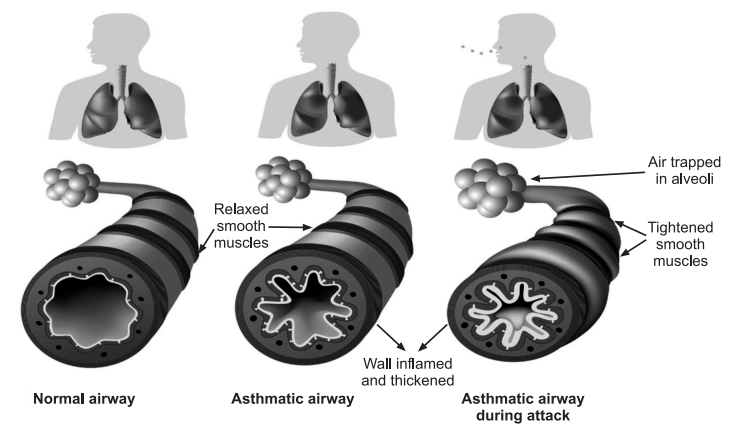Asthma | What Is Asthma |asthma icd 10
Asthma is a chronic inflammatory disorder of the airways associated with variable (usually reversible) airflow obstruction and enhanced bronchial hyper responsiveness to a variety of stimuli.
Causes of Asthma in Human Body
Asthma is characterized by excessive sensitivity of the lungs to various stimuli. There is increasing evidence to suggest genetics play an important role in the etiology of the disease. Apparently, environmental factors interact with inherited factors to increase the
risk of asthma. Environmental triggers range from viral infections and allergies, to
irritating gases and particles in the air. Each person reacts differently to the factors that
may trigger asthma. Physiological factors that may trigger or increase asthma symptoms include:
• Viral upper respiratory infections.
• Heavy exercise.
• Untreated conditions such as rhinitis, sinusitis, and gastroesophageal reflux (GERD).
• Drugs: NSAIDS such as aspirin.
• Ibuprofen, acetaminophen, naproxen sodium and Ketoprophen; statin drugs (cholesterol reducing medications) and other anti inflammatory drugs.
• Stress and strong emotions.
• Menstrual cycle/hormone changes.
Physiological factors that may trigger or increase asthma symptoms include:
- Viral upper respiratory infections.
- Heavy exercise.
- Untreated conditions such as rhinitis, sinusitis, and gastroesophageal reflux (GERD).
- Drugs: NSAIDS such as aspirin.
- Ibuprofen, acetaminophen, naproxen sodium and Ketoprophen; statin drugs (cholesterol reducing medications) and other anti inflammatory drugs.
- Stress and strong emotions.
- Menstrual cycle/hormone changes.by food allergies, with a greater percentage occurring in children. Reactions can occur within a few minutes or over a period of several hours. Undiagnosed and untreated, severe attacks can be fatal. Based upon causes, the asthma is divided into two types:
-
a. Intrinsic asthma: Usually develop beyond age 40 and have many causes other than exposure to allergens.
-
b. Extrinsic asthma: Most commonly develop in childhood and caused by exposure to definite allergens
Classification of Asthma
Current classification is based on clinical severity. This allows asthma sufferers and clinicians to better manage treatment choices and clinical outcomes.
-
Mild Intermittent Asthma: It occurs in people with daytime symptoms that occur no more frequently than twice a week and night-time symptoms that occur no more than twice a month. These people are usually asymptomatic with normal Peak Expiratory Flow Rate between exacerbations. Exacerbations vary in intensity but are usually brief, lasting only hours to days. They do not take daily medications for long term control, only short for quick relief.
-
Mild Persistent Asthma: It is characterized by daytime symptoms that occur more than twice a week but less than once a day with night-time symptoms more frequent than twice a month. These people are asymptomatic but have abnormal pulmonary function tests. Exacerbations begin to limit their activity. They usually take one medication on a daily basis for long term control. Using medications for quick relief on a daily basis indicates a need for additional long term therapy.
-
Moderate Persistent Asthma: It occurs in people who have daytime symptoms every day and night-time symptoms more than once a week. Exacerbations limit their activity and occur at least twice a week, and may last for several days. These individuals take one or two long term control medications. Also using medications for quick relief on a daily basis indicates a need for additional long term therapy.
-
Severe Persistent Asthma: It is characterized by continual daytime symptoms and frequent night-time symptoms. They experience limited physical activity and exacerbations are frequent. These people often take two medications daily for long term control. Also using medications for quick relief on a daily basis indicates a need for additional long term therapy.
More Reads:

